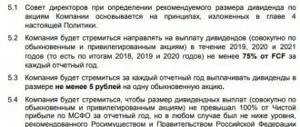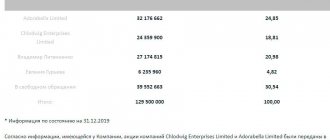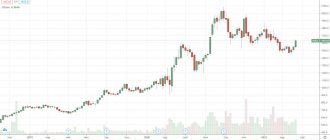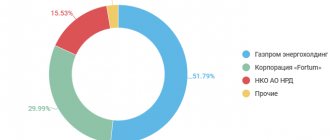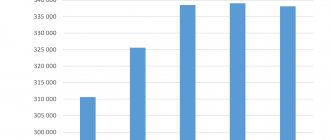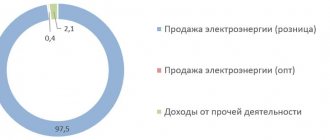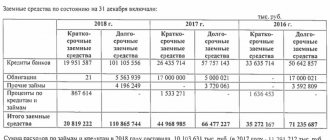There will be no dividends yet, but!
Let's start with the bad news - the company will not pay dividends for 2021. It needs to normalize liquidity after leaving sanctions. Plus, as far as I understand, the new Board of Directors does not want to take any drastic steps and looks to the future conservatively.
However, the company confirms that its dividend policy remains unchanged after the IPO and they plan to consider an interim dividend for 2021 no later than the fall. Let me remind you that this policy is as follows: payment of 100% of dividends from Rusal and 75% of the Net Cash Flow of the energy segment, but not less than $250 million per year.
Rusal's dividend policy is the payment of 15% of the covenant EBITDA, which is calculated taking into account Norilsk Nickel's dividends.
This is the most important thing in the report, since it is quite obvious that the company is extremely cheap relative to the cash flow it generates and the main question is how it will manage it.
Impact of MMC dividends on Rusal's performance
Hi all!
This post will be about Rusal, but it is logically connected with the future dividend flow from MMC Norilsk Nickel. The share in MMC and its dividends represent an additional investment business segment of Rusal. Rusal itself identifies it in IFRS as Mining and Metals . The Mining and Metals segment includes the equity investment in PJSC MMC Norilsk Nickel (“Norilsk Nickel”).
Let's start with the mining and metallurgical complex. I relied on the calculations collected for this post:
I increased the accuracy of the revenue forecast by collecting prices for nickel, copper, platinum and palladium for each day of the second half of the year and derived average prices. I assessed the sales volumes again.
I did not change the rest of the inputs in the model.
The result is two sets of dividend yield options, i.e. with the current formula and a potential new formula, judging by the presentation of NN, in the floating formula instead of 1.8 Net debt/EBITDA will become 1.5.
In the simulation for this spreadsheet, the price per share and EV/EBITDA multiple are derived from the specified dividend yield rate. The average industry multiplier for mining with non-ferrous metal is now 6.7. MMC may well trade at a premium of 1 – 1.5 as a large chip with a healthy financial position.
The potential reduction in dividends attributable to Rusal will be $123 million. Rusal is a tax non-resident in the Russian Federation, therefore a 15% tax is withheld.
Now let's move directly to Rusal . In order to have a basis for assessing the impact of the reduction in dividends from the mining and metals industry, we had to write a model for 2017-2018. I didn’t write further than 2021, because... Rusal is very sensitive to the price of aluminum, and a horizon of 2 years is enough to understand what effect will be from a change in the dividend flow in favor of Rusal, and whether there is any point in worrying about this, or to focus on monitoring the price of aluminum and production reports.
Revenue:
Sales volumes : LTM production indicators for aluminum amount to 930 million tons per quarter. For the purposes of the forecast for the next 5 quarters, I included the same volume as going to sales. The company sells a little more than it currently produces, but currently has a lot of inventory. We'll take a little bite out of it.
Aluminum prices : for the model, I took prices from the LME for the 4th quarter of 2021, added a premium and received a conservative 2170 USD per ton. For 2021, I have set the base option at 2200 USD per ton. From my point of view, this is a moderately optimistic option, given the growing shortage in the world. But to make the model more informative, I calculated the range of options in increments of $100.
In addition to the sale of aluminum itself, there is revenue from the related sale of bauxite (7.5% of revenue) and foil (3.2% of revenue). The company has other income from the sale of electricity and transport (5.3% of revenue). For the purity of the experiment, I equated other income in 2021 to 2021, especially since in 2021 they fell relative to 2021, and in 2017 they grew slightly. Let's just say that with a significant drop in the price of basic aluminum, they will not help much. I generally ignore revenue from cryptocurrencies, believing that 170 million is a “sunk cost” and it’s better not to think about them.
Cost price. Rusal tries to keep production costs well optimized. In 2021, I still indexed a lot of expenses (salaries, energy, raw materials).
CAPEX. I have set $170 million in capex for the next 5 quarters. These include renovations and projects announced by the company itself.
Investment in MMC Rusal holds a 27.82% stake in MMC Norilsk Nickel. What does this mean from an IFRS accounting perspective?
Rusal has significant influence over the mining and metals industry, but no control. Accounting in this case is carried out as an “investment in associate”, using the “equity” method Equity method: a method of accounting by which an equity investment is initially recorded at cost and subsequently adjusted to reflect the investor's share of the net assets of the associate ( investee). https://www.iasplus.com/en/standards/ias/ias28
Profit or loss from an investment is calculated as the change in the balance during the reporting period. The total is reflected in the line “Share of profits of associates and joint ventures”.
All dividends that come in affect cash flow and covenant EBITDA for the purpose of calculating Rusal's own dividends. Receiving a smaller dividend means it can pay off fewer debt payments or buy less of anything in CAPEX.
Based on the MMC model, I made a simple illustration of what it might look like at the end of 2021 and 2021. I equated the 2021 profit in the MMC to 2021, although it will obviously be higher. I did not model the full year 2018 in MMC. The exchange rate difference will also not be zero, depending on the dynamics of exchange rates.
Let's summarize the calculations
Looking ahead, I’ll say right away that the dividend flow from the mining and metals industry is not as important as the price of aluminum. The potential reduction in payments by $123 million per year is completely offset by the increase in the average price of aluminum from 2200 to 2233 USD per ton. The valuation of the share in MMC is not based on the market price to reflect the financial result, but textual disclosure is made in the notes to the financial statements.
The valuation for 2021 in the model is based on the industry average multiple (EV/EBITDA = 6.7).
The company does not have dilutive instruments convertible into shares, so in EV I take the base number of shares. I will not subtract Rusal’s share in MMC from EV; in my calculation it will remain part of Rusal’s business.
Dividend yield is calculated in accordance with the announced policy, within 15% of the covenant EBITDA. Calculated based on the option with a reduced div flow from Norilsk Nickel.
Model summary table.
I believe that 2100 USD per ton in the current state of the aluminum market is a fairly realistic lower level for Rusal's selling prices. The market plays into the hands of the company's shareholders. If someone is afraid of a reduction in payments from Norilsk Nickel, and quotes drop below 40 rubles, you will know that not everything is so dramatic. You can purchase more if you wish.
Net cash flow of the metallurgical segment fell, but the energy segment is stable
Let's take an illustration from a presentation on the company's Net Cash Flow (hereinafter referred to as NCF):
We see that operating cash flow in the metals segment was significantly lower than last year, despite higher EBITDA. $680 million versus $1,702 last year, or a drop from 80% of EBITD to 31%. The reason is known; the company's sales were cut off and it was forced to work in a warehouse.
But in the energy segment, operating cash flow is stable and even increased from $952 million to $1,039 million. I note that operating cash flow in this segment even increased relative to EBITD, which was $1,147 million in 2021 and $1,174 million in 2021 from 83% to 88%. This is quite logical; you can’t put electricity in a warehouse.
This operating cash flow was almost entirely used to pay interest and capex. expenses.
Dividends on Rusal shares in 2021 - size and register closure date
Home → Dividends→ Rusal shares - forecast, payment history
The Rusal company has not been paying dividends since 2021 due to US sanctions. All free cash flow is used to pay off debt.
A table with the complete history of dividends of the Rusal company indicating the amount of payment, the date of closure of the register and the forecast:
| Payment, rub. | Registry closing date | Last day of purchase |
| 1.14 | September 8, 2017 | 06.09.2017 |
| 1.08 | September 30, 2016 | 28.09.2016 |
| 0.888384 | October 28, 2015 | 26.10.2015 |
*Note 1: The Moscow Exchange operates on the T+2 trading system. This means that settlements for buying and selling shares occur within 2 business days. Therefore, to be included in the register of shareholders and receive dividends, you must be a shareholder 2 days before the cutoff.
*Note 2: Exact payout date varies by broker and issuer. The predicted earliest date for receipt of dividends to the brokerage account for RUSAL JSC: January 14, 1970.
Total dividends of Rusal shares by year and changes in their size compared to the previous year:
| Year | Amount for the year, rub. | Change, % |
| 2017 | 1.14 | +5.56% |
| 2016 | 1.08 | +21.57% |
| 2015 | 0.888384 | n/a |
| Total = 3.108384 |
The amount of dividends paid by Rusal for the entire period is 3.108384 rubles.
Average amount for 3 years: 1.04 rubles, for 5 years: 0.622 rubles.
You can buy Rusal shares with minimal commissions from stock brokers: Finam and BCS. Free deposits and withdrawals. Online registration.
Brief information about the issuer Rusal
| Sector | Metals and mining |
| Issuer's full name | RUSAL OK MKPAO JSC |
| Issuer's name is short | RUSAL JSC |
| Ticker on the stock exchange | RUAL |
| Number of shares in lot | 10 |
| Number of shares | 15 193 014 862 |
| Free float, % | 16 |
Other companies from the Metals and Mining sector
| # | Company | Div. profitability for the year, % | The nearest registry closing date | Buy before |
| 1. | ALROSA JSC | 14,99% | 04.07.2021 | 30.06.2021 |
| 2. | NLMK JSC | 14,91% | 09.06.2021 | 07.06.2021 |
| 3. | MMK | 11,80% | 17.06.2021 | 15.06.2021 |
| 4. | TMK JSC | 10,87% | — | — |
| 5. | SevSt-ao | 10,31% | 01.06.2021 | 28.05.2021 |
Calendar with upcoming and past dividend payments
| Immediate | Past | ||||
| Company Sector | Size, rub. | Registry closing date | Company Sector | Size, rub. | Registry closing date |
| RusAqua JSC Foodstuff | 5 | 27.05.2021 | MDMG-gdr Miscellaneous | 19 ✓ | 25.05.2021 |
| FGC UES JSC Energy | 0.016 | 29.05.2021 | TransK JSC Logistics | 403.88 ✓ | 24.05.2021 |
| SevSt-ao Metals and mining | 46.77 | 01.06.2021 | M.video Retail trade | 38 ✓ | 18.05.2021 |
| Tattel. JSC Telecoms | 0.0393 | 01.06.2021 | PIK JSC Construction | 22.51 ✓ | 17.05.2021 |
| SevSt-ao Metals and mining | 36.27 | 01.06.2021 | PIK JSC Construction | 22.92 ✓ | 17.05.2021 |
| GMKNorNik Metals and mining | 1021.2 | 01.06.2021 | Moscow Exchange Finance and Banking | 9.45 ✓ | 14.05.2021 |
| MOESK Energy | 0.0493 | 01.06.2021 | Sberbank Finance and Banking | 18.7 ✓ | 12.05.2021 |
View full calendar for 2021 »
7 Best Dividend Stocks for 2021
| # | Company | Sector | Dividend yield for the year, % | The nearest registry closing date | Buy before |
| 1. | Surgnfgz-p | Oil Gas | 16,84% | 20.07.2021 | 16.07.2021 |
| 2. | iMMTSB JSC | Miscellaneous | 15,24% | 09.06.2021 | 07.06.2021 |
| 3. | Unipro JSC | Energy | 15,08% | 22.06.2021 | 18.06.2021 |
| 4. | ALROSA JSC | Metals and mining | 14,99% | 04.07.2021 | 30.06.2021 |
| 5. | NLMK JSC | Metals and mining | 14,91% | 09.06.2021 | 07.06.2021 |
| 6. | Rusagro | Food | 11,85% | 18.09.2021 | 15.09.2021 |
| 7. | MMK | Metals and mining | 11,80% | 17.06.2021 | 15.06.2021 |
View the full company rating for 2021 »
Interesting read:
- Full description: how to buy shares for an individual;
- How to enter the stock exchange as a private individual;
- Exchange Traded Funds - Questions and Answers;
- Investment portfolio - what is it;
- How can you live on dividends?
- How to buy Gazprom shares for an individual;
- What is the profit of the shares;
- Investing in shares - step-by-step instructions;
← Return to main catalog
The company's balance sheet has improved significantly
Inventories in the warehouse have grown significantly, cash too, even accounts receivable have grown a little. At the same time, accounts payable and loans decreased.
There is a lot mixed up in this balance (the same 99% reserves belong to Rusal in which En+ has 56.55%), but it is obvious that the balance has become stronger.
And the company’s leverage has decreased significantly as an energy segment:
So and metallurgical:
Forecast for increase
In 2021, Kazakhtelecom plans to maintain a high level of income. “Our revenue forecast is 530-550 billion tenge, with the actual figure for 2021 amounting to 527 billion tenge. At the same time, I would like to remind you that the planned revenue figure for last year was in the range of 480-500 billion tenge, that is, in practice, in 2020 we managed to significantly exceed our own forecast,” Askhat Uzbekov emphasized.
According to him, after one quarter it is still difficult to say whether the company, like last year, will be able to exceed projected revenue.
“One thing is clear for now: the preliminary results of the first quarter indicate that the indicators specified in the forecast are being maintained,” Uzbekov said.
Photo: Kazakhtelecom He assured the participants of the online meeting that the company’s management will continue to pay great attention to the issues of financial stability management this year. In December 2021, the company carried out an early repurchase of bonds worth 25 billion tenge, thus repaying one-fourth of the debt raised to finance the purchase of a 75% stake in Kcell JSC at the end of 2021.
“Since we carried out a lot of activity in acquiring assets in 2018-2019, the main debts are at the level of Kazakhtelecom. The level of debt burden is 3.3. At subsidiaries it is much lower; accordingly, the intra-group level of debt burden is 1.7,” Uzbekov said.
The amount of current capital expenditures of the group of companies is planned at a fairly high level - 22%-26% of revenue. This is due to the implementation of a large-scale project to integrate networks of mobile operators, as well as planned costs for expansion and modernization of the network by both mobile operators and Kazakhtelecom itself.
“We plan to invest very actively in our mobile operators this year. We believe that this will allow us to maintain and maintain our operating performance, as well as improve the quality of communication for our subscribers,” said a member of the board of Kazakhtelecom JSC.
At the same time, the company expects to maintain a high level of business margins - EBITDA margin is expected to be maintained at 45%-47% this year.
What will happen to the company next?
The Board of Directors, independent of Deripaska and headed by Lord Barker, should gradually bring the company back to normal (if, of course, a Russian company with a non-traditional orientation at the Chairman of the Board of Directors can be considered normal):
SD strategy:
- Restoring the business so it works as before
- Continuation of investment projects in both the metallurgical and energy segments.
- Debt reduction
- And if it works out (and it should work out), then the dividends will be returned.
In general, the company, apparently, is waiting for another sad quarter (the 4th quarter was weak, because sanctions finally began to affect the company), and then a gradual recovery of business. I think we will see it in the results by the middle, or even the end of 2021.
Now to the company's valuation.
Dividends are growing
The dividend yield on common shares of Kazakhtelecom at the end of 2021 amounted to 6.4%, on preferred shares - about 11-12%. If we compare these data with similar indicators for other telecommunications companies in emerging markets, it becomes obvious that Kazakhtelecom’s dividend yield is one of the highest.
The high dividend proposed by the board of directors was made possible due to strong operating and financial performance in 2020. The revenue of the group of companies over the past year increased by 23.8% compared to 2021 and amounted to 527 billion against 469 billion tenge. EBITDA also increased - the amount of profit received before deducting interest, taxes, depreciation and amortization - from 209 billion tenge in 2019 to 246 billion tenge in 2020. The EBITDA margin, in particular, amounted to 46.7%, which is higher than the average among peer companies in both developed and emerging markets. At the same time, Kazakhtelecom managed to significantly reduce the ratio of debt to EBITDA - from 2.1 to 1.71, which contributed to increasing the financial stability of the group.
The group's operating performance also grew in 2021. Demand has increased significantly during the pandemic, when people were forced to spend most of their time at home. Both the number of fixed-line and pay TV subscribers, as well as the level of broadband access, increased. A slight decrease was noted only in the number of mobile subscribers. This is due to the fact that many SIM cards were taken out of circulation due to tightening regulation. However, this was offset by a significant increase in average revenue per user (ARPU) - the figure increased by 15%, to 5,862 tenge per subscriber.
How to evaluate En+ and Rusal?
In general, valuing any company is a complex task, and although theoretically the best method is DCF, in practice it is very difficult to do correctly, so it is simply simplified using valuation using multiples. But which multiplier is better to take? or evaluate it in some other way? I think my readers are well familiar with this topic and are now wondering why I am writing this. And I am writing this to warn you that my assessment of the company may differ both from your assessment and from the fair one. Therefore, after reading, do not hesitate to share your assessment in the comments.
So. The first method is through dividends
JSC Kazakhtelecom notifies its shareholders about the results of the annual General Meeting of Shareholders
On agenda item No. 1 “On approval of the annual financial statements of Kazakhtelecom JSC for 2021”
In accordance with subparagraph 7) of paragraph 1 of Article 36 of the Law of the Republic of Kazakhstan “On Joint Stock Companies” and subparagraph 13) of paragraph 1 of Article 29 of the Charter of Kazakhtelecom JSC, the annual General Meeting of Shareholders of Kazakhtelecom JSC DECIDED:
Approve the annual financial statements (consolidated and separate) of Kazakhtelecom JSC for 2021 in accordance with Appendices 1 - 4 to this decision.
To make a decision on this issue in accordance with paragraph 2 of Article 36 of the Law of the Republic of Kazakhstan “On Joint Stock Companies”, a simple majority of votes of the total number of voting shares of the company participating in voting is required.
Based on the voting results, the DECISION WAS MADE UNANIMOUSLY.
On issue No. 2 of the meeting agenda “On the procedure for distributing net profit of Kazakhtelecom JSC for 2021”
In accordance with subparagraph 1 of Article 36 of the Law of the Republic of Kazakhstan “On Joint Stock Companies” and paragraph 3 of Article 24, subparagraph 15) of paragraph 1 of Article 29 of the Charter of Kazakhtelecom JSC, the annual General Meeting of Shareholders of Kazakhtelecom JSC DECIDED:
1 of Article 36 of the Law of the Republic of Kazakhstan “On Joint Stock Companies” and paragraph 3 of Article 24, subparagraph 15) of paragraph 1 of Article 29 of the Charter of Kazakhtelecom JSC, the annual General Meeting of Shareholders of Kazakhtelecom JSC DECIDED:
1. Approve the following procedure for the distribution of net income of Kazakhtelecom JSC for 2021:
71.2% of the consolidated net income amounting to 24,717,821,000 (twenty-four billion seven hundred seventeen million eight hundred twenty-one thousand) tenge should be used to pay dividends for 2021;
leave the remaining part at the disposal of Kazakhtelecom JSC.
2. Approve the amount of dividends for 2021 on common shares in the amount of 1.595 (one thousand five hundred ninety-five) tenge 79 (seventy-nine) tiyn per 1 common share.
3. Fix the list of shareholders entitled to receive dividends based on the results of 2021, as of 00:00 on the first Sunday after the date of the annual General Meeting of Shareholders.
4. Determine the start date for the payment of dividends on common shares based on the results of 2021 - the next business day after the date of fixing the list of shareholders entitled to receive dividends based on the results of 2017 within one month.
5. Approve the payment procedure - in one lump sum.
6. Approve the form of payment of dividends on shares of Kazakhtelecom JSC, located at the address: Astana, Yesil district, st. Sauran, 12, details: BIN 941240000193, IIC KZ779261802104233017 in the Almaty branch of Kazkommertsbank JSC, BIC KZKOKZKX, Kbe16 - in money, by non-cash payment to the shareholder’s bank account.
To make a decision on this issue in accordance with paragraph 2 of Article 36 of the Law of the Republic of Kazakhstan “On Joint Stock Companies”, a simple majority of votes of the total number of voting shares of the company participating in voting is required.
Based on the voting results, the DECISION WAS MADE UNANIMOUSLY.
On issue No. 3 of the meeting agenda “On the election of the Board of Directors of Kazakhtelecom JSC”
In accordance with subparagraph 5) paragraph 1 of Article 36 of the Law of the Republic of Kazakhstan “On Joint Stock Companies” and subparagraph 10) of paragraph 1 of Article 29 of the Charter of Kazakhtelecom JSC, the annual General Meeting of Shareholders of Kazakhtelecom JSC DECIDED:
1. Terminate early the powers of all members of the Board of Directors of Kazakhtelecom JSC.
2. Elect the following persons to the Board of Directors of Kazakhtelecom JSC for the period provided for by the Charter of Kazakhtelecom JSC, from the date of the annual General Meeting of Shareholders of the Company:
1) Baidauletov Nurzhan Talipovich - representative of the interests of the shareholder of the Company - Samruk-Kazyna JSC;
2) Saudabaev Serik Bolatovich - representative of the interests of the shareholder of the Company - Samruk-Kazyna JSC;
3) Esekeyev Kuanyshbek Bakytbekovich - Chairman of the Board of Kazakhtelecom JSC;
4) Erulan Aitashovich Kusainov - representative of the interests of the Company’s shareholder - Sobrio Limited;
5) Dmitry Anatolyevich Prikhozhan - representative of the interests of the Company’s shareholder - Sobrio Limited;
6) Buyanov Alexey Nikolaevich - as an independent director;
7) Garrett Martin Johnston - as an independent director;
 Zaika Dmitry Aleksandrovich - as an independent director;
Zaika Dmitry Aleksandrovich - as an independent director;
9) Naizabekov Timur Kurmangazievich - as an independent director.
To make a decision on this issue in accordance with paragraph 2 of Article 36 and paragraph 3 of Article 54 of the Law of the Republic of Kazakhstan “On Joint Stock Companies”, a simple majority of votes of the total number of voting shares of the company participating in voting is required. This is due to the fact that since one candidate is running for one seat on the Board of Directors, in this case cumulative voting is not applied.
Based on the voting results, the DECISION WAS MADE UNANIMOUSLY.
Note:
Adilbek Sarsenov did not move from the previous composition to the new one, who was replaced by Erulan Kusainov, as well as a new member of the council, Timur Naizabekov.
Valuation of En+ and Rusal through dividends
According to the dividend policy, Rusal must pay 15% of the covenant EBITDA, which means Rusal's EBITDA + Norilsk Nickel dividends.
Rusal's EBITDA in the last two years was $2,120 million and $2,163 million, while the company received $783 million from Norilsk Nickel in 2021, and $887 million in 2021. Thus, Rusal had to allocate $435 million and $457 million .
At the same time, judging by Potanin’s latest statements (Norilsk Nickel needs money for investment projects and dividends should be reduced) and the situation on the aluminum market this year, the figure will be lower. How much less is an open question, but I would focus on approximately $350-400 million; for simplicity of further calculations, I will use the figure of $375 million. At an exchange rate of ₽65, this will give approximately ₽1.6 dividends per share or ~5% dividend yield at the current price paper (a little more if you don’t take into account personal income tax, a little less if you take it into account).
But this is for today, and Rusal is a paper with a potentially growing dividend yield. Let's take a scenario in which Rusal fully pays off its debts, completes investment projects itself and directs all free cash flow to dividends. Moreover, Norilsk Nickel is also doing the same at this point. What will we get then?
Let's assume the aluminum market recovers a little and the company generates $2,100 million in EBITDA and receives another $1,000 from Norilsk Nickel. Total 3,100 minus 500 for supporting capital costs and minus 500 income tax (20% of 3,100 - 500 capital costs, since we will consider them equal to depreciation). 2'100 left for dividends! At the same rate, this will be ₽9 per share! This may seem like an ideal scenario, but it is entirely achievable.
How much should such paper cost? I got a simple estimate of about ₽60. Thus, the paper should cost at least ₽50.
Now to the evaluation of En+
En+ plans to direct 75% of its cash flow to dividends, plus whatever it receives from Rusal. The company generates EBITDA of about $1,150 million and this figure is quite stable. The company spends it on capex. costs are about $200 million (the last two years have been less, but they plan to increase capex) and just under $400 million in interest on bank loans. That leaves $550 million minus another $110 million for income taxes. The result was $440 million. NPV from which the company will allocate $330 million for dividends. The company will also gradually reduce debt, but the pace will be very calm, i.e. the number will grow slowly. And let’s add here the dividends that Rusal will send.
According to my estimate, the cost of paper should be about ₽1,150. Then, under constant conditions, I will partially begin exiting the position in the region of ₽1'000
I think the logic is clear to everyone, you can play with numbers and assumptions to get your estimate.
Now there is another evaluation method that is a little closer to me.
Rusal. Is it worth taking
What happened
On January 27, the US Treasury Department OFAC lifted sanctions against UC Rusal, En+ and Eurosibenergo. Previously, these companies were controlled by Oleg Deripaska. However, the reduction of shares in the companies and the change of the board of directors led to a loss of control and made it possible to lift sanctions from the companies.
Strictly speaking, the Ministry of Finance’s intentions to lift sanctions from companies have been known for a long time. And the US Congress received the corresponding notice on January 19 and was unable to block the process.
On the eve of the introduction of sanctions on April 5, 2021, Rusal shares cost 34.4 rubles. Thus, the stock is trading below the pre-sanction level by 16%.
How aluminum prices have changed during sanctions
It is interesting to look at the percentage dynamics of Rusal and aluminum shares in rubles after the introduction of sanctions in April 2021. The shares naturally dropped sharply. Since Rusal is one of the largest global suppliers of products, aluminum responded with growth due to the expected supply shortage due to sanctions.
In addition, these were Washington’s most serious restrictive measures in several decades, which put great pressure on the entire Russian market and the ruble exchange rate. The price of aluminum in rubles soared in proportion to the fall in share prices.
What do we have at the moment? Since the sanctions, aluminum has grown by more than 7%, Rusal shares on the Moscow Exchange are in the red by 16%. If we do not expect a sharp decline in metal prices in the near future, for example, due to a slowdown in the global economy, this imbalance may disappear in the medium term by restoring the company's quotations on the Moscow Exchange.
New Board of Directors
Before the imposition of sanctions, the main shareholder of Rusal (48%) was En+, which was 70% owned by Oleg Deripaska. As a result of efforts to remove companies from sanctions, Deripaska's stake in En+ was reduced to 44.95%. And the exchange of Glencore's 8.75% stake in Rusal for a 10.55% stake in En+, according to our data, ultimately led to the following capital structure of Rusal:
Thus, control over Rusal will be concentrated with En+. There are three independent directors out of nine on Rusal’s board of directors.
As a result of the change in EN+'s capital structure, the share of shares that previously controlling shareholder Deripaska can vote with has been reduced to 35%. He can nominate four candidates to the board of directors. VTB owns 22%, but can only vote within 6%. The remaining shares, in accordance with the agreement with the US Treasury, will be voted on by American trusts through independent directors.
In turn, the number of independent members of the En+ board of directors increased from three to eight. The new independent directors are Christopher Bancroft Burnham, Carl Hughes, Joan McNaughton, Nicholas Jordan, Igor Lozhevsky, Alexander Chmel and Andrey Sharonov. Lord Gregory Barker remained Chairman of the Board of Directors.
The updated board of the company will give a chance for a new impetus for the development of the company, because in essence, control will be concentrated among independent directors and minority shareholders. This somewhat increases the likelihood of the company developing in a way that will prioritize growth in shareholder value.
In addition to a fundamentally new board of directors, Rusal and En+, as part of the deal with the US Treasury, committed themselves to ensuring unprecedented transparency of their activities, auditing, certification and reporting, which is always appreciated by investors.
Dividends
Rusal's dividend history is not impressive. The difficult financial situation does not allow us to pay 50% of the company's profits. A return to payments after the sanctions are lifted could be a nice bonus.
According to the dividend policy, shareholders could receive 15% of covenant EBITDA, i.e. including dividends from Norilsk Nickel. Deleveraging could significantly increase payouts. If the debt to equity ratio is reduced below the ratio of 3 to 1, the company can increase dividends to 50% of IFRS profits. This, by the way, was the main driver of shares before the sanctions. Since 2015, Rusal has paid dividends three times, but only interim ones. Latest for the first half of 2021 at $0.0197 per share. Taking into account the dividend policy and the potential decision to return to payments in 2018, one could expect $0.023-0.024 per share. Data is presented based on adjusted EBITDA for the last 12 months starting from Q3. 2021
MSCI
Several months before the imposition of sanctions, Rusal shares were one of the main contenders for inclusion in the MSCI Russia index. The key admission criterion was the increase in free-float to 16% as a result of the sale of shares by the majority shareholder. But then the securities did not pass through liquidity. As soon as the situation normalizes after the sanctions are lifted, we can again consider such a factor in the growth of the company’s capitalization.
Rusal is still inexpensive
Before the introduction of sanctions, Rusal was trading at 7.5-8x LTM P/E. After the announcement of the restrictions, to this day the coefficient has not risen above 4x. Currently it is 2.9x. The metals and mining sector's average P/E for the next 12 months is around 6x.
According to Reuters consensus forecasts, Rusal's expected earnings per share in 2021 will be $0.12 and will remain around this level in 2021. P/E ratio for the next 12 months. according to forecasts it should be 3.5x.
Separately, we can mention the cost of Rusal's package in Norilsk Nickel. UC Rusal owns a 27.82% stake in MMC Norilsk Nickel. Since the introduction of sanctions on April 6, 2021 and to date, the value of the package has increased by 25%, based on stock quotes on the Moscow Exchange.
What's the result?
Sanctions against Rusal have been lifted, but the stock has not returned to its previous absolute or relative price in terms of P/E. This should take into account changes in the board of directors, commitments to more transparent reporting and auditing, as well as changes in the price of aluminum in rubles over this period. As pleasant bonuses, we can note the possibility of returning to dividend payments and hypothetical inclusion in MSCI. Considering all these points, the stock looks undervalued at current quotes. According to average P/E estimates of the Russian metallurgical sector, the stock's growth potential can range from 15-20%.
BCS Broker
Kazakhtelecom - Dividend payments may increase in the medium term
November 17, 2016
Given the potential dividend yield, as well as more attractive multiples compared to peers, we recommend HOLDing common shares and BUYing preferred shares of the company. According to our calculations, the growth potential is 10.3% for common shares and 40% for preferred shares.
Positive consolidated financial results for the first half of the year . Revenue growth was achieved due to increased income from the rental of communication channels and growth in revenue from data transmission. Net profit increased significantly in 1H16, due to the recognition of profit from discontinued operations as a result of the loss of control over the subsidiary Altel as a result of its merger with Tele 2. Net profit to shareholders of the parent company amounted to 56,984 million tenge, and profit from continuing operations amounted to 14,786 million tenge, decreasing by 14% due to the recognition of a share of loss in an associate.
We forecast that fixed-line revenues will continue to decline by approximately 3% per annum starting in 2021, driven by market saturation, an increase in the share of smartphones, and a shift in user interests towards alternative communication methods such as WhatsApp, Viber and Skype. Data transmission services will remain the main growth driver. We expect revenue growth from this segment to slow to an estimated 5% in 2021, tapering to 4% by 2021.
Key industry trends . Over the course of 5 years, one could observe a gradual decline in the growth rate of revenue from voice communications and the flow of income into the data services sector. Since 2013, revenue from data services has been the largest source of revenue, offsetting the decline in revenue from voice services. Also, due to market saturation, growth rates in mobile telephony have slowed down.
Among the negative factors, we would like to note the low liquidity of shares . The average daily volume for 3 months was 5.5 million tenge for common shares and 2.8 million tenge for preferred shares. The liquidity of the company's shares is not high, which suggests that an investor may have difficulty selling a large volume of securities.
The size of the dividend at the end of 2021 may be in the range of 986-2,300 tenge with a distribution of 15%-35% of the consolidated net profit. A significant reduction in capital expenditures in 2021, as well as an increase in profitability and profitability, argues in favor of a higher dividend. During the period from 2018-22. we expect a dividend payout of 30%. The average dividend yield will be approximately 6.6%. However, we believe that the increase in dividend payments for 2016 is already partially reflected in the price of common shares.
Kazakhtelecom looks undervalued in terms of P/E and EV/EBITDA multiples in comparison with peer companies. The average P/E of comparable companies today is over 17, while Kazakhtelecom's is 5.1, implying a 70% discount. Based on the EV/EBITDA multiple, the discount to comparable companies is 64%.
Our target price for Kazakhtelecom common shares is 15,007 tenge/share , which implies an increase in value by 10.3% and 9,754 tenge/share for preferred shares (+40%). We recommend “BUYing” the company’s preferred securities, taking into account the potential dividend yield of more than 14%, and “ HOLDing” Kazakhtelecom common shares.


